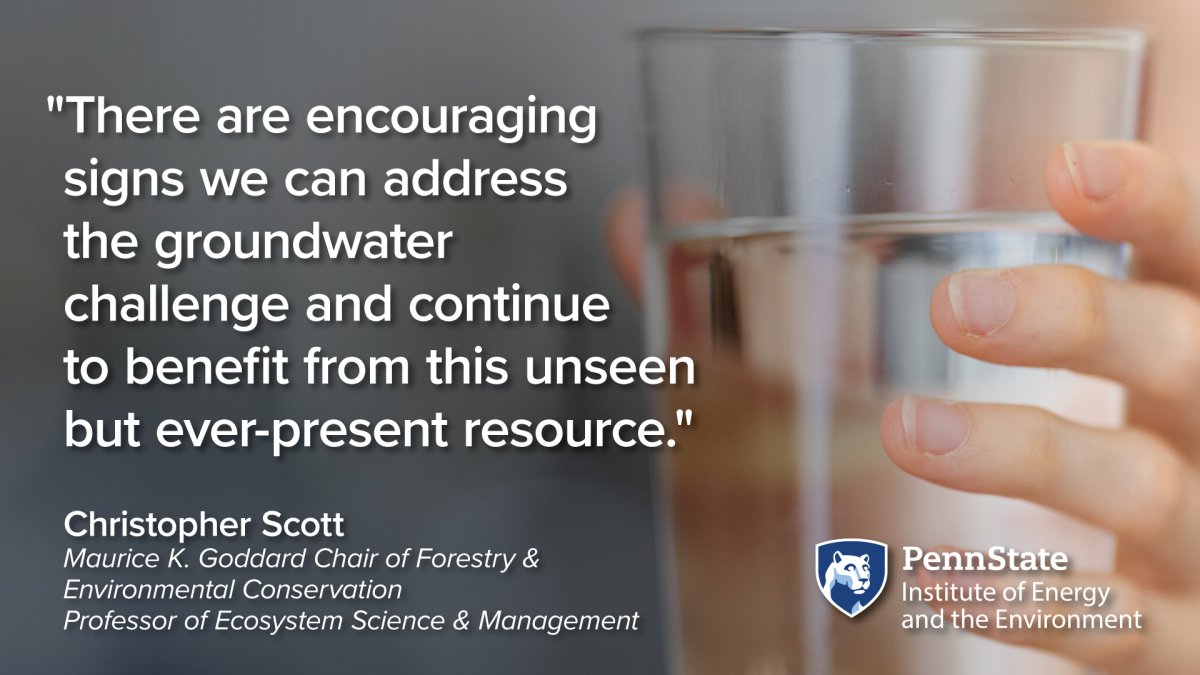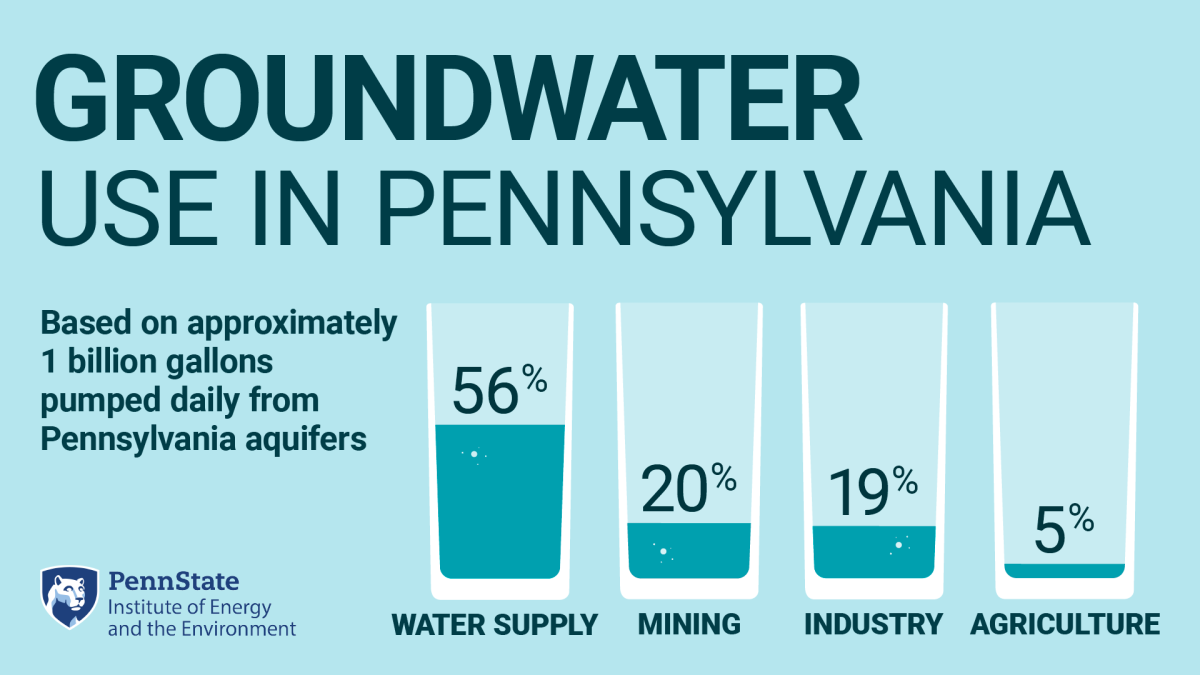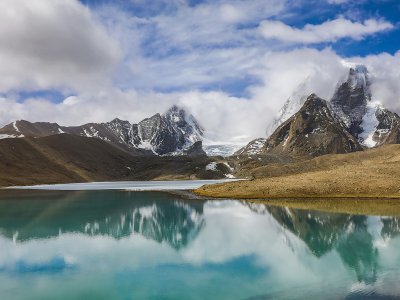If you live in State College or any smaller town, township, or rural area across Pennsylvania–outside the major metropolitan areas, for that matter–you probably drink groundwater. If you live in the U.S. West or, for instance, the Middle East, parts of India (the world’s largest user of groundwater), or other dryland regions around the world, you very likely drink groundwater and depend on it for a range of other needs, especially irrigation of crops.
Groundwater is just that—water from underground, pumped from a well or piped from a spring. This contrasts with surface water in creeks, rivers, and lakes, although the two types of water are connected. Groundwater originates as rainfall that runs off the land surface and infiltrates through the soil and recharges deeper geological formations known as aquifers. And in many locations, especially in summer when hot, dry conditions limit runoff into rivers, the low-flow water in the channel is actually groundwater released into the river.

But humans’ relationship with groundwater is in deep trouble. Since the middle of the 20th century after the invention of high-capacity pumps and widespread electrification in the U.S. and many countries globally, we have begun to pump groundwater faster than it is replenished through infiltration and recharge. Granted, this has brought prosperity to farming regions through irrigation supply. Groundwater access greatly simplified the challenge of drinking water supply because it’s usually cheaper to source groundwater locally than to build a dam and pipe the water to population centers. Additionally, groundwater often requires less treatment to make it safe and potable, and it has a lower environmental impact than constructing dams and pipelines for surface water capture, storage, and supply. In fact, groundwater supply in many areas has become the default.

The decline in groundwater is exacerbated by climate change, which tends to make surface water less reliable because of longer droughts and dry spells, and more intense flooding that can affect dams and reservoirs. With each successive cycle of drought, new or rehabilitated groundwater wells come into service. But once dams refill (as for instance it taking place in the fall and winter of 2023 in California after atmospheric rivers brought torrential floods that partially alleviated severe drought), rarely is groundwater pumping stopped. We are hooked on this cheap and easy source of water.
We have become so addicted to groundwater that, in many areas, we’re pumping it dry. California’s Central Valley has witnessed sustained declines not just in groundwater levels but in the land sinking (through a process called subsidence), resulting both in cracks, fissures, and damage to buildings and roads on the land surface, but also to irreversible loss of the capacity of the underground aquifer to hold water even when it is available at the surface for aquifer recharge, because now the gaps and spaces that used to hold water have collapsed through subsidence.

Other symptoms of groundwater modification through human activity include acid mine drainage, often from coal mining–and even once mining stops, we can have legacy effects. As a result, although groundwater may be physically available, often the quality is so negatively impacted, and cleanup is such an expensive and long drawn-out process that there is a scarcity of acceptable-quality groundwater.
A litany of challenges! But what about solutions? Fortunately, human-caused problems can have human-devised solutions. But “just say no” (groundwater bans, for example) is invariably ineffective because enforcement of the amount of groundwater pumped usually relies on self-reporting, and in cases where pumps are fitted with meters, getting routine readings to ensure compliance can be an expensive procedure. Limiting new wells or requiring minimum spacing from existing nearby wells are standard approaches; however, these steps are often taken after the total installed capacity to pump exceeds recharge; in other words, the aquifer is already in decline.
Many liken groundwater to a tragedy of the commons, a free-for-all resource that experiences depletion and quality degradation resulting from the total of users extracting more than the resource can sustainably supply. In some cases, groundwater is effectively an open-access resource, but in many regions, we have devised groundwater management plans and regulations on its use.
In others, managed aquifer recharge intentionally diverts surface water from a river or other water body to specially prepared facilities that hold water on highly permeable land that allows it to rapidly flow into the aquifer, thereby storing it underground. This is extensively practiced in arid Western states like Arizona and California. A highly effective practice, managed aquifer recharge relies on an available and legally approved source of surface water. In California’s recent floods (mentioned earlier), there were efforts to undertake stormwater recharge–again, an effective practice that still does require permitting of the facility used for recharge, which in turn can run experience barriers to siting the large lagoons in landscapes where wetlands, riverfront properties, and other desirable land uses already occupy such locations.
There is growing consensus that demand management, instead of or maybe coupled with supply augmentation, is necessary. Many regions encourage or even require the adoption of water-efficient technology like drip irrigation instead of conventional application of water in long furrows running down the field, or sprinkler and spray irrigation (including from center pivot irrigation in the telltale circular fields that can be seen when flying over extensive areas of the West and Midwest, for example). While efficient irrigation application is an important conservation strategy, this should be accompanied by a switch to lower water-consuming crops and even the shift of cropping season to periods with lower temperatures and more humid conditions that reduce water demand. But what happens to the saved water? If it’s used for other productive purposes and not held back in the aquifer, it doesn’t necessarily help the depletion problem–a technical and regulatory challenge I have worked on extensively.
Taken individually, these approaches may not work to their intended effect. But, put together as a package, there are encouraging signs we can address the groundwater challenge and continue to benefit from this unseen but ever-present resource.
Christopher Scott is an IEE faculty member, the Maurice K. Goddard Chair of Forestry and Environmental Conservation and a professor of ecosystem science and management. His research, extension, and engagement focus on natural resource conservation and policy, climate-smart forestry, watershed science and management, the water-energy-food nexus, interstate and transboundary waters, climate adaptation and resilience, and energy transitions, with emphasis on the Appalachians, Alleghenies, and international efforts in the Andes and Himalayas.





